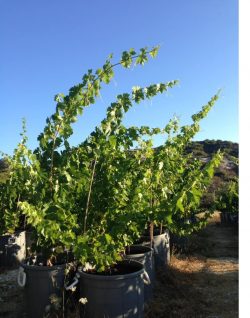Image: Dr Alexander Copper, PhD student at the University of Adelaide, standing next to recently imported Cypriot vine cuttings.
Australian grapegrowers are increasingly being tested by the effects of climate change on their vineyard operations, with extreme weather events, water scarcity and compressed vintages becoming more common challenges across numerous regions.
While some producers may have an eye on new and alternative varieties better suited to the shifting conditions, one researcher at the University of Adelaide sees grapevines from Cyprus as potentially offering a solution. Journalist Samuel Squire spoke to him to find out more.
As temperatures rise due to climate change, grape and wine producers may need to reconsider which vine species they have growing in their vineyards in order to survive and keep producing high quality fruit and wine.
In the middle of the Mediterranean lies the small island nation of Cyprus where more drought-tolerant vine species have been growing for hundreds, if not thousands, of years. These vine species, like Maratheftiko and Xynisteri, are reportedly more resilient to hotter, drier temperatures and are suited to less-to-no irrigation during the warmer months, according to a PhD student at the University of Adelaide.
|
|
Alexander Copper was first introduced to Cypriot winegrape varieties while working in Cyprus in 2010 for the late Dr Akis Zambartas, a renowned Cypriot oenologist.
During his time on the island, he says that Dr Zambartas, alongside a French ampelographer in the 1980s, discovered that indigenous Cypriot vine varietals were drought tolerant and could survive harsh, hot conditions. “The varieties are very drought tolerant and grow vigorously surviving only on winter rainfall with most vineyards using bush vines and no irrigation,” he said. “Xynisteri is the most widely cultivated variety in Cyprus and Maratheftiko was identified by Dr Zambartas as being the red variety with the most potential [for Australian use].” |
|
|
Trialling the vines under Australian conditions
In 2019, the first Maratheftiko and Xynisteri vines imported from Cyprus were released from Australian quarantine and were planted under a trial program to test their irrigation needs in Australia. Copper believes that the decision to import and plant Cypriot vine species in Australia comes from the necessity for the wine industry to survive and be more sustainable as water supply lessens and temperatures continue to rise.
|
“The majority of [grapevine] varieties currently grown in Australia originate in France and other European wine regions, which traditionally have abundant rainfall,” he said.
“In Australia, these European varieties require [quite substantial] irrigation to thrive and, with the current climate change conditions, this is becoming increasingly difficult.
“Our goal is to find alternative varieties that can survive with little or potentially no irrigation.”
Copper says that his ambitions for Cypriot vines in Australia is mainly to offer an alternative to the current varieties being cultivated.
He adds there is also potential for extremely drought tolerant varieties to be used in breeding programmes to produce drought tolerant varieties with traditional variety sensory characteristics.
For coping with Australia’s climate, Copper says the results of trialling the Cypriot vines last year proved fruitful.
“Last year we completed some irrigation trials in Cyprus and compared Xynisteri and Maratheftiko to Sauvignon Blanc and Shiraz,” he said.
“The results from this show both of the Cypriot varieties, Maratheftiko and Xynisteri, have excellent drought-coping mechanisms and perform far better than Sauvignon Blanc and Shiraz in dealing with drought.”
Copper says that most traditional Cypriot vineyards are situated on limestoneheavy soils and that initial trials will be based at the university’s vineyard site, but he plans to take them to other regions for further suitability testing.
Cypriot wines, according to Copper, may have solid potential in the Australian wine market, as he says, in his first study of the varieties, “The wines produced from Cypriot varieties are very good”.
“The first paper also included an Australian consumer trial comparing wines made from Xynisteri and Maratheftiko grapes with Australian Shiraz, Pinot Gris and unwooded Chardonnay,” he continued.
“The Cypriot wines were rated very well in comparison with the Australian wines and, in some cases, the Cypriot wines were preferred to their Australian rivals.”
This article was originally published in the July issue of The Australian & New Zealand Grapegrower & Winemaker. To find out more about our monthly magazine, or to subscribe, click here!
To uncork more about the rich history of Cypriot vines and their use in the production of Cypriot Commandaria wine, click here.
Are you a Daily Wine News subscriber? If not, click here to join our mailing list. It’s free!























